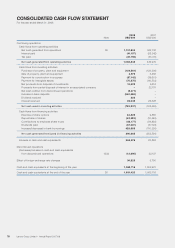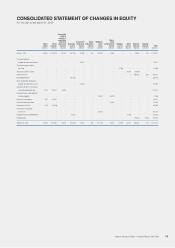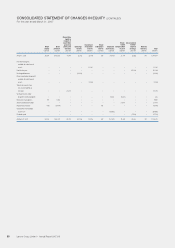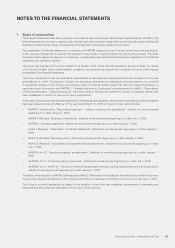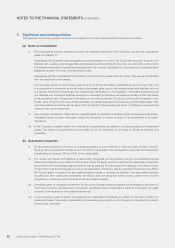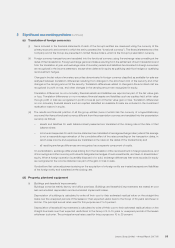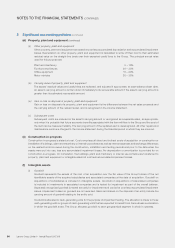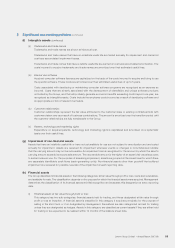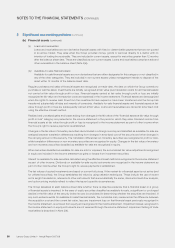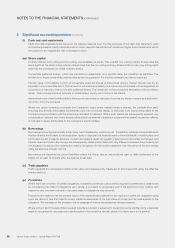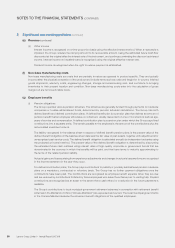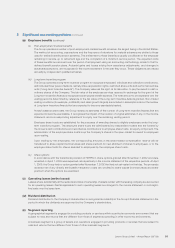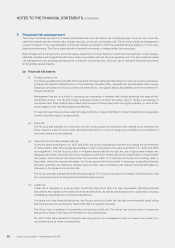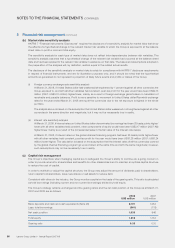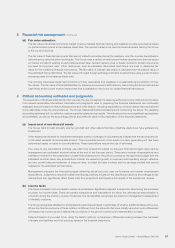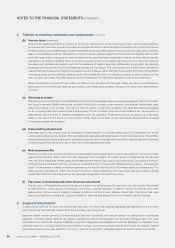Lenovo 2008 Annual Report Download - page 90
Download and view the complete annual report
Please find page 90 of the 2008 Lenovo annual report below. You can navigate through the pages in the report by either clicking on the pages listed below, or by using the keyword search tool below to find specific information within the annual report.
NOTES TO THE FINANCIAL STATEMENTS (CONTINUED)
2 Significant accounting policies (continued)
(l) Cash and cash equivalents
Cash and cash equivalents are carried in the balance sheet at cost. For the purposes of the cash flow statement, cash
and cash equivalents mainly comprise cash on hand, deposits held at call with banks and highly liquid investments which
are subject to an insignificant risk of changes in value.
(m) Share capital
Ordinary shares, both voting and non-voting, are classified as equity. The unlisted non-voting ordinary shares have the
same rights as the listed voting ordinary shares save that the non-voting ordinary shares shall not carry any voting rights
until they are converted into listed ordinary shares.
Convertible preferred shares, which are mandatorily redeemable on a specific date, are classified as liabilities. The
dividends on these convertible preferred shares are recognized in the income statement as interest expense.
The fair value of the liability portion of convertible preferred shares is determined using a market interest rate for an
equivalent non-convertible bond. This amount is recorded as a liability on an amortized cost basis until extinguished on
conversion or maturity of the convertible preferred shares. The remainder of the proceeds is allocated to the conversion
option. This is recognized and included in shareholders’ equity, net of income tax effects.
Incremental costs directly attributable to the issue of new shares or exercise of options are shown in equity as a deduction,
net of tax, from the proceeds.
Where any group company purchases the Company’s equity share capital (treasury shares), the consideration paid,
including any directly attributable incremental costs (net of income taxes), is deducted from equity attributable to the
Company’s equity holders until the shares are cancelled or reissued. Where such shares are subsequently reissued, any
consideration received (net of any directly attributable incremental transaction costs and the related income tax effects)
is included in equity attributable to the Company’s equity holders.
(n) Borrowings
Borrowings are recognized initially at fair value, net of transaction costs incurred. Transaction costs are incremental costs
that are directly attributable to the acquisition, issue or disposal of a financial asset or financial liability, including fees and
commissions paid to agents, advisers, brokers and dealers, levies by regulatory agencies and securities exchanges, and
transfer taxes and duties. Borrowings are subsequently stated at amortized cost; any difference between the proceeds (net
of transaction costs) and the redemption value is recognized in the income statement over the period of the borrowings
using the effective interest method.
Borrowings are classified as current liabilities unless the Group has an unconditional right to defer settlement of the
liability for at least 12 months after the balance sheet date.
(o) Trade payables
Trade payables are recognized initially at fair value and subsequently measured at amortized cost using the effective
interest method.
(p) Provisions
Where there are a number of similar obligations, the likelihood that an outflow will be required in settlement is determined
by considering the class of obligations as a whole. A provision is recognized even if the likelihood of an outflow with
respect to any one item included in the same class of obligations may be small.
Provisions are measured at the present value of the expenditures expected to be required to settle the obligation using
a pre-tax discount rate that reflects current market assessments of the time value of money and the risks specific to the
obligation. The increase in the provision due to passage of time is recognized as interest expense.
Where some or all of the expenditure required to settle a provision is expected to be reimbursed by another party, a separate
asset is recognized for any expected reimbursement that would be virtually certain if a claim were to be settled.
Lenovo Group Limited • Annual Report 2007/08
88


